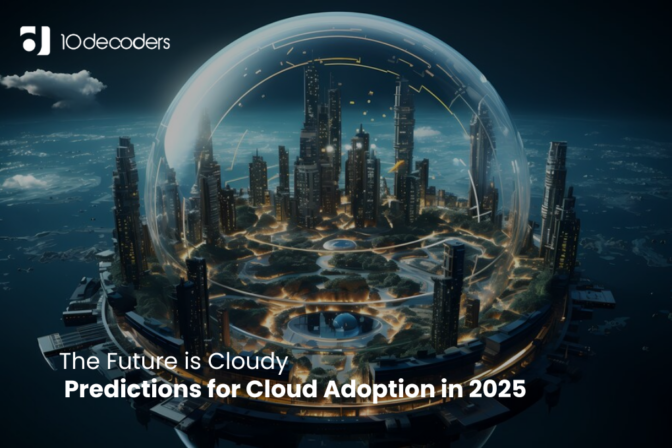The Future is Cloudy: Predictions for Cloud Adoption in 2025
As we enter the new decade, the cloud computing landscape continues to evolve at a rapid pace, driven by technological advancements, changing business needs, and shifting market dynamics. Looking ahead to 2025, several key trends and potential disruptions are expected to shape the future of cloud adoption. In this blog, we’ll analyze these trends and predictions to provide insights into the evolving landscape of cloud computing and its impact on businesses and industries.
Edge Computing Emergence
One of the prominent trends in cloud computing is the emergence of edge computing. Edge computing extends the capabilities of the cloud to the edge of the network, enabling real-time processing and analysis of data closer to its source. With the proliferation of Internet of Things (IoT) devices and the increasing demand for low-latency applications, edge computing is poised to become a critical component of cloud infrastructure in 2025. Organizations will leverage edge computing to support use cases such as autonomous vehicles, smart cities, and industrial automation, driving innovation and efficiency across various industries.
Quantum Computing Integration
Another transformative trend in cloud computing is the integration of quantum computing capabilities. Quantum computing offers unparalleled processing power and computational capabilities, enabling organizations to tackle complex problems and perform tasks that are currently infeasible with traditional computing architectures. In 2025, we can expect to see cloud providers offering quantum computing services as part of their offerings, enabling businesses to harness the power of quantum algorithms for optimization, simulation, and machine learning tasks. Quantum computing integration will revolutionize industries such as healthcare, finance, and materials science, unlocking new opportunities for innovation and discovery.
Multi-Cloud and Hybrid Cloud Adoption
Multi-cloud and hybrid cloud adoption will continue to gain momentum in 2025 as organizations seek to optimize performance, mitigate risks, and avoid vendor lock-in. With multi-cloud architectures, businesses can leverage multiple cloud providers to distribute workloads, improve resilience, and optimize costs. Similarly, hybrid cloud environments, which combine on-premises infrastructure with public and private cloud services, offer flexibility and scalability while addressing data sovereignty and compliance requirements. In 2025, we’ll see increased adoption of multi-cloud and hybrid cloud strategies as organizations embrace the benefits of distributed computing and strive for greater agility and innovation.
AI and Machine Learning Integration
Artificial intelligence (AI) and machine learning (ML) will play a central role in driving innovation and transformation in cloud computing in 2025. Cloud providers will continue to invest in AI and ML capabilities to enhance services such as predictive analytics, natural language processing, and computer vision. Organizations will leverage AI and ML to automate processes, gain actionable insights from data, and deliver personalized experiences to customers. In addition, AI-driven security solutions will help organizations detect and respond to cyber threats more effectively, ensuring the integrity and confidentiality of data in the cloud.
Enhanced Security and Compliance
Security and compliance will remain top priorities for cloud adoption in 2025 as organizations grapple with increasingly sophisticated cyber threats and stringent regulatory requirements. Cloud providers will continue to enhance security measures such as encryption, identity and access management, and threat detection to protect data and applications in the cloud. Additionally, advancements in compliance automation and governance tools will help organizations ensure adherence to regulatory standards and industry best practices, facilitating cloud adoption across highly regulated sectors such as healthcare, finance, and government.
Blockchain Integration
In the coming years, we can expect to see increased integration of blockchain technology with cloud computing. Blockchain, known for its distributed ledger capabilities and immutable record-keeping, offers potential solutions for enhancing security, transparency, and trust in cloud environments. Cloud providers may offer blockchain-as-a-service (BaaS) platforms, enabling organizations to deploy and manage blockchain networks seamlessly. With blockchain integration, businesses can secure transactions, verify data integrity, and streamline processes such as supply chain management, identity verification, and digital rights management. The combination of blockchain and cloud computing holds promise for revolutionizing various industries and driving innovation in areas such as finance, logistics, and healthcare.
Green Cloud Computing
Sustainability will become a key consideration for cloud adoption in 2025, leading to the rise of green cloud computing initiatives. As concerns about climate change and environmental impact continue to grow, organizations will seek to reduce their carbon footprint and energy consumption associated with cloud infrastructure. Cloud providers will invest in renewable energy sources, energy-efficient data centers, and carbon offset programs to promote sustainability and minimize environmental impact. Green cloud computing initiatives will not only benefit the environment but also enable organizations to demonstrate corporate social responsibility and attract environmentally conscious customers and partners. By embracing green cloud computing practices, businesses can align with sustainability goals while reaping the benefits of cloud technology.
Conclusion
The future of cloud computing is bright and promising, with exciting trends and innovations on the horizon. From the emergence of edge computing and quantum integration to the continued adoption of multi-cloud and hybrid cloud strategies, businesses will leverage cloud technology to drive agility, innovation, and growth in 2025 and beyond. By embracing these trends and staying ahead of disruptions, organizations can harness the full potential of cloud computing to achieve their strategic objectives and thrive in the digital economy.



